
Neste 27 de novembro, 2019, foto, uma instalação de painel solar foi vista no condado de Ruicheng, na província de Shanxi, na China central. Enquanto os líderes mundiais se reúnem em Madrid para discutir como desacelerar o aquecimento do planeta, um holofote está caindo sobre a China, o maior emissor de gases de efeito estufa. A China queima cerca de metade do carvão usado globalmente a cada ano. No entanto, é também o principal mercado de painéis solares, turbinas eólicas e veículos elétricos. (AP Photo / Sam McNeil)
Enquanto os líderes mundiais se reúnem na Espanha para discutir como diminuir o aquecimento do planeta, um destaque recai sobre a China - o maior emissor de gases de efeito estufa.
A China queima cerca de metade do carvão usado globalmente a cada ano. Entre 2000 e 2018, suas emissões anuais de carbono quase triplicaram, e agora representa cerca de 30% do total mundial. No entanto, é também o principal mercado de painéis solares, turbinas eólicas e veículos elétricos, e fabrica cerca de dois terços das células solares instaladas em todo o mundo.
"Estamos testemunhando muitas contradições no desenvolvimento de energia da China, "disse Kevin Tu, um bolsista baseado em Pequim com o Centro de Política de Energia Global da Universidade de Columbia. "É o maior mercado de carvão e o maior mercado de energia limpa do mundo."
Esse aparente paradoxo é possível devido à enorme escala das demandas de energia da China.
Mas, à medida que a economia da China desacelera para o nível mais baixo em um quarto de século - cerca de 6% de crescimento, de acordo com estatísticas do governo - os legisladores estão dobrando o apoio ao carvão e outras indústrias pesadas, a espinha dorsal tradicional do sistema energético e da economia da China. Ao mesmo tempo, o país está reduzindo subsídios para energia renovável.
Na cúpula anual do clima das Nações Unidas, este ano em Madrid, representantes do governo darão os toques finais na implementação do Acordo de Paris de 2015, que estabeleceu uma meta de limitar o aquecimento futuro de 1,5 a 2 graus Celsius acima dos níveis pré-industriais. As nações podem decidir por si mesmas como alcançá-lo.

Neste 28 de novembro, 2019, foto, uma instalação de painel solar foi vista no condado de Ruicheng, na província de Shanxi, na China central. Enquanto os líderes mundiais se reúnem em Madrid para discutir como desacelerar o aquecimento do planeta, um holofote está caindo sobre a China, o maior emissor de gases de efeito estufa. A China queima cerca de metade do carvão usado globalmente a cada ano. No entanto, é também o principal mercado de painéis solares, turbinas eólicas e veículos elétricos. (AP Photo / Sam McNeil)
A China já havia se comprometido a mudar sua matriz energética para 20% de energias renováveis, incluindo energia nuclear e hidrelétrica. Especialistas em clima geralmente concordam que as metas iniciais prometidas em Paris não serão suficientes para atingir a meta, e no próximo ano as nações deverão articular metas mais ambiciosas.
As esperanças de que a China se ofereça para fazer muito mais estão diminuindo.
Relatórios recentes da mídia e imagens de satélite sugerem que a China está construindo ou planejando concluir novas usinas a carvão com capacidade total de 148 gigawatts - quase igual a toda a capacidade de energia a carvão da União Europeia nos próximos anos, de acordo com uma análise da Global Energy Monitor, uma organização sem fins lucrativos com sede em San Francisco.
Separadamente, o investimento em energia renovável da China caiu quase 40 por cento no primeiro semestre de 2019 em comparação com o mesmo período do ano passado, de acordo com a Bloomberg New Energy Finance, uma organização de pesquisa. O governo cortou subsídios para energia solar.

Neste 27 de novembro, 2019, foto, uma instalação de painel solar foi vista no condado de Ruicheng, na província de Shanxi, na China central. Enquanto os líderes mundiais se reúnem em Madrid para discutir como desacelerar o aquecimento do planeta, um holofote está caindo sobre a China, o maior emissor de gases de efeito estufa. A China queima cerca de metade do carvão usado globalmente a cada ano. No entanto, é também o principal mercado de painéis solares, turbinas eólicas e veículos elétricos. (AP Photo / Sam McNeil)
Na semana passada em Pequim, O vice-ministro da Ecologia e Meio Ambiente da China disse a repórteres que as fontes de combustíveis não fósseis já respondem por 14,3% da matriz energética do país. Ele não indicou que a China adotaria metas mais rigorosas em breve.
“Ainda enfrentamos desafios para desenvolver nossa economia, melhorando a vida das pessoas, "Zhao Yingmin disse.
A China é alternadamente considerada o pior vilão do clima do mundo ou seu potencial salvador de energia limpa, mas ambos os superlativos estão um tanto mal colocados.
Como uma economia em rápido crescimento, sempre foi inevitável que as demandas de energia da China aumentassem vertiginosamente. A única questão era se o país poderia abastecer uma porção suficientemente grande de sua economia com energias renováveis para conter o crescimento das emissões.
Muitos observadores ficaram esperançosos com uma breve queda nas emissões de carbono da China entre 2014 e 2016, bem como a declaração do líder chinês Xi Jinping em 2017 de que a China "assumiu uma posição de liderança na cooperação internacional para responder às mudanças climáticas".

Neste 28 de novembro, 2019, foto, uma instalação de painel solar foi vista no condado de Ruicheng, na província de Shanxi, na China central. Enquanto os líderes mundiais se reúnem em Madrid para discutir como desacelerar o aquecimento do planeta, um holofote está caindo sobre a China, o maior emissor de gases de efeito estufa. A China queima cerca de metade do carvão usado globalmente a cada ano. No entanto, é também o principal mercado de painéis solares, turbinas eólicas e veículos elétricos. (AP Photo / Sam McNeil)
Hoje, o foco renovado do país no carvão é uma decepção.
"Agora há uma sensação de que, em vez de ser um líder, A China é a que está fora de compasso, "disse Lauri Myllyvirta, analista líder do Centro de Pesquisa em Energia e Ar Limpo em Helsinque. Ele observa que vários países desenvolvidos, incluindo a Alemanha, Coréia do Sul e Estados Unidos - estão reduzindo rapidamente sua dependência da energia do carvão.
Combustíveis fósseis, como carvão, a gasolina e o gás natural liberam dióxido de carbono na atmosfera, aprisionando o calor e mudando o clima. O carvão é o maior culpado.
Ano passado, o consumo de carvão nos Estados Unidos atingiu o nível mais baixo em quase 40 anos, de acordo com a Administração de Informações de Energia dos EUA.
Um lugar para considerar o aumento, pause and rise again of China's coal sector is Shanxi province—a vast mountainous region in central China.
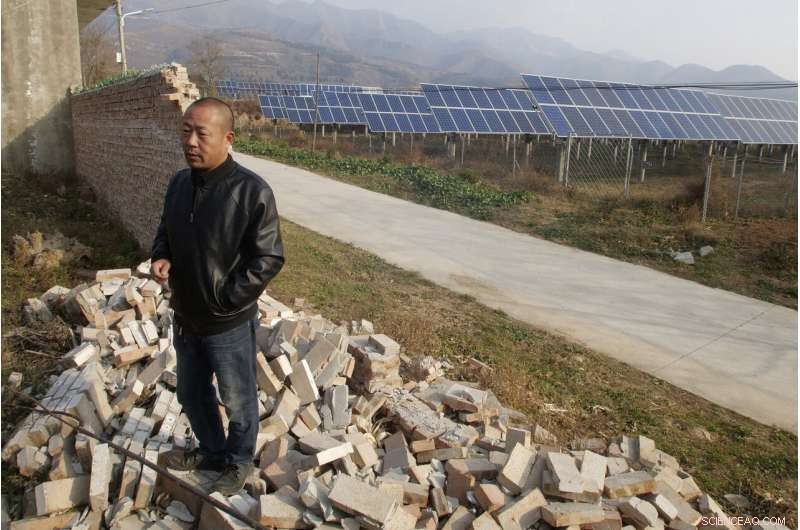
In this Nov. 28, 2019, foto, Chan Shicun, a construction materials trader, points to a wall he said local authorities destroyed after a disagreement with a massive government-backed solar project in Ruicheng County in central China's Shanxi Province. As world leaders gather in Madrid to discuss how to slow the warming of the planet, a spotlight is falling on China, the top emitter of greenhouse gases. China burns about half the coal used globally each year. Yet it's also the leading market for solar panels, wind turbines and electric vehicles. (AP Photo/Sam McNeil)
Shanxi is the heart of China's traditional coal country, dotted with large mines, but also the site of some of the country's largest solar and wind-power projects, de acordo com a mídia estatal.
During most of the past 30 years of rapid economic growth, the coal business boomed in Shanxi and nearby provinces. As China's cities and industries expanded, coal supplied much of that power, and China surpassed the U.S. as the world's top carbon emitter in 2006.
But after climbing sharply for two decades, China's emissions stalled around 2013 and then declined slightly in 2015 and 2016, according to Global Carbon Budget, which tracks emissions worldwide. This dip came as Chinese leaders declared a "war on pollution" and suspended the construction of dozens of planned coal power plants, including some in Shanxi.
Ao mesmo tempo, the government required many existing coal operators to install new equipment in smokestacks to remove sulfur dioxide, nitrous oxide and other hazardous substances. About 80% of coal plants now have scrubbers, said Alvin Lin, Beijing-based China climate and energy policy director for the Natural Resources Defense Council, a nonprofit.
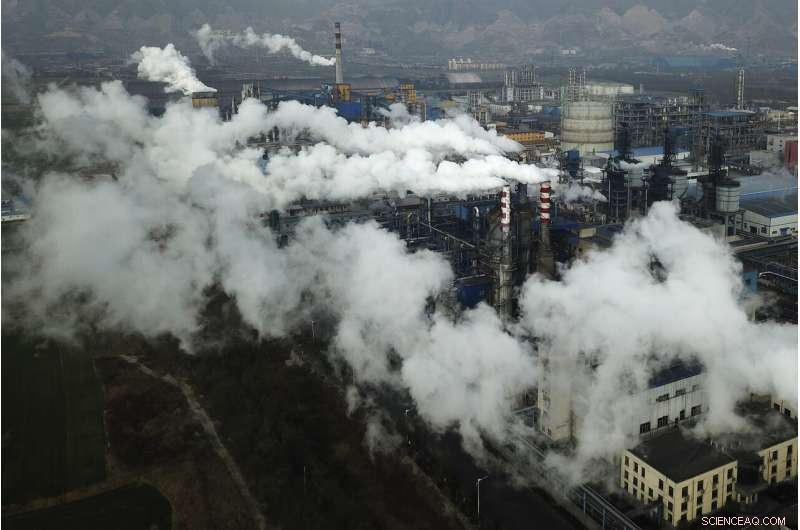
In this Nov. 28, 2019, foto, smoke and steam rise from a coal processing plant that produces carbon black, an ingredient in steel manufacturing, in Hejin in central China's Shanxi Province. As world leaders gather in Madrid to discuss how to slow the warming of the planet, a spotlight is falling on China, the top emitter of greenhouse gases. China burns about half the coal used globally each year. Yet it's also the leading market for solar panels, wind turbines and electric vehicles. (AP Photo/Sam McNeil)
Como resultado, the air quality in many Chinese cities, incluindo Pequim, improved significantly between 2013 and 2017. Residents long accustomed to wearing face masks and running home air-filter machines enjoyed a reprieve of more "blue sky days, " as low-pollution days are known in China.
Annual levels of PM 2.5—a tiny but dangerous pollutant—dropped by roughly a third across China between 2013 and 2017, from 61.8 to 42 micrograms per cubic meter, according to scientists at Beijing's Tsinghua University and other institutions. They made the report in November in the Proceedings of the National Academy of Sciences , a peer-reviewed journal.
"That's a big improvement, although in terms of safe air quality, we're still not there yet, " Lin said. China's pollution levels are still well above standards set by the World Health Organization.
While these retrofitted coal plants emit fewer pollutants that harm human health, the scrubbers do not reduce greenhouse gases. "The new plants are good for air quality, but you still have all that carbon dioxide that goes into the atmosphere, "Lin disse.

In this Nov. 28, 2019, foto, a coal storage facility is seen in Hejin in central China's Shanxi Province. As world leaders gather in Madrid to discuss how to slow the warming of the planet, a spotlight is falling on China, the top emitter of greenhouse gases. China burns about half the coal used globally each year. Yet it's also the leading market for solar panels, wind turbines and electric vehicles. (AP Photo/Sam McNeil)
In the past three years, China's carbon emissions have begun to rise again, according to Global Carbon Budget.
That trend was evident in the first half of 2019, when China's carbon emissions from fossil fuels and concrete production rose 4%, compared with the same period last year, according to Myllyvirta's preliminary analysis of Chinese government data.
The coming winter in Beijing may see a return of prolonged smog, as authorities loosen environmental controls on heavy industry—in part to compensate for other slowing sectors in the economy. Cement and steel production remain both energy intensive and heavily polluting.
Permits for new coal plants proliferated after regulatory authority was briefly devolved from Beijing to provincial governments, which see construction projects and coal operations as boosts to local economies and tax bases, said Ted Nace, executive director of Global Energy Monitor.

In this Nov. 28, 2019, foto, a solar panel installation is seen in Ruicheng County in central China's Shanxi Province. As world leaders gather in Madrid to discuss how to slow the warming of the planet, a spotlight is falling on China, the top emitter of greenhouse gases. China burns about half the coal used globally each year. Yet it's also the leading market for solar panels, wind turbines and electric vehicles. (AP Photo/Sam McNeil)
"It's as though a boa constructor swallowed a giraffe, and now we're watching that bulge move through the system, " said Nace. In China, it takes about three years to build a coal plant.
Em novembro, Premier Li Keqiang gave a speech to policymakers emphasizing the importance of domestic coal to energy security.
But because China's coal-power expansion is growing faster than energy demand, overcapacity "is a serious concern now, " said Columbia University's Tu.
And once new infrastructure is built, it's hard to ignore.
"It will be politically difficult to tear down a brand-new coal plant that's employing people and supporting a mining operation. It will make it more difficult for China to transition away from coal, " Nace said.
The world has already warmed by 1 degree Celsius. All scenarios envisioned by the Intergovernmental Panel on Climate Change for holding planetary warming to around 1.5 degrees Celsius involve steep worldwide reductions in coal-power generation.
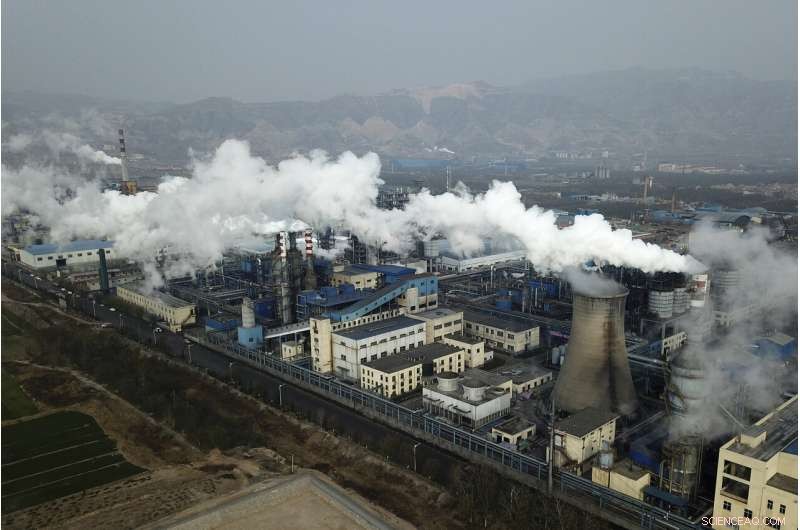
In this Nov. 28, 2019, foto, smoke and steam rise from a coal processing plant that produces carbon black, an ingredient in steel manufacturing, in Hejin in central China's Shanxi Province. As world leaders gather in Madrid to discuss how to slow the warming of the planet, a spotlight is falling on China, the top emitter of greenhouse gases. China burns about half the coal used globally each year. Yet it's also the leading market for solar panels, wind turbines and electric vehicles. (AP Photo/Sam McNeil)
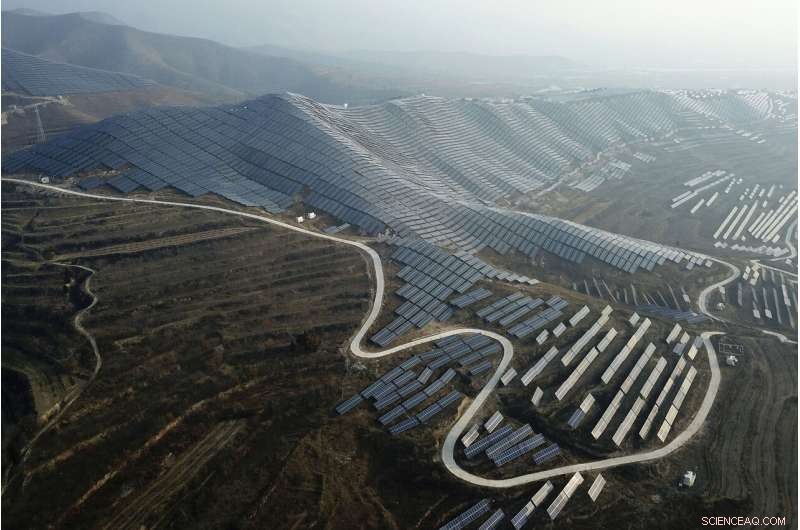
In this Nov. 28, 2019, foto, a solar panel installation is seen in Ruicheng County in central China's Shanxi Province. As world leaders gather in Madrid to discuss how to slow the warming of the planet, a spotlight is falling on China, the top emitter of greenhouse gases. China burns about half the coal used globally each year. Yet it's also the leading market for solar panels, wind turbines and electric vehicles. (AP Photo/Sam McNeil)
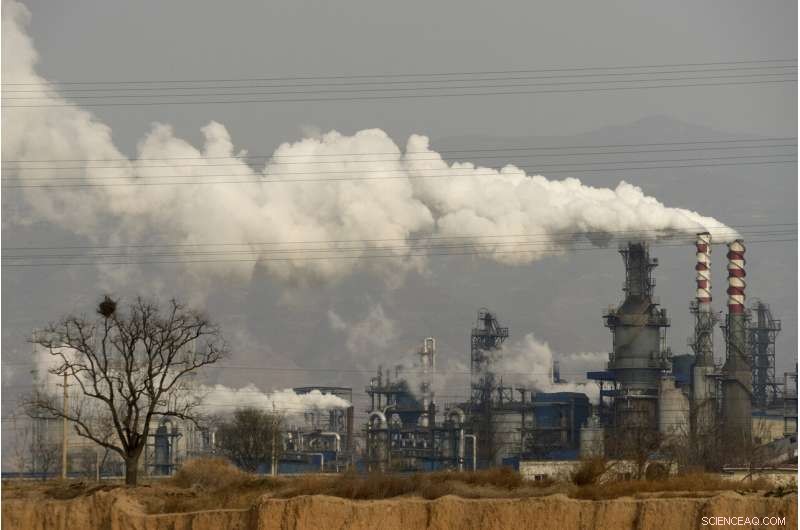
In this Nov. 28, 2019, foto, smoke and steam rise from a coal processing plant that produces carbon black, an ingredient in steel manufacturing, in Hejin in central China's Shanxi Province. As world leaders gather in Madrid to discuss how to slow the warming of the planet, a spotlight is falling on China, the top emitter of greenhouse gases. China burns about half the coal used globally each year. Yet it's also the leading market for solar panels, wind turbines and electric vehicles. (AP Photo/Olivia Zhang)
In that effort, other countries rely on China to manufacture most of the solar panels installed worldwide, according to an analysis in the journal Ciência co-authored by Jonas Nahm, an energy expert at Johns Hopkins University.
"If we have any chance to meet climate targets, we have to do a lot by 2030—and we won't be able to do it without China's clean-energy supply chain, " Nahm said.
China's manufacturing helped bring down the cost of solar panels by 80% between 2008 and 2013. Prices for wind turbines and lithium-ion batteries also dropped significantly, according to Bloomberg New Energy Finance.
"China has a really mixed record. On the one hand, it's seen rapidly rising emissions over the past two decades, " Nahm said. "On the other hand, it's shown it's able to innovate around manufacturing—and make new energy technologies available at scale, faster and cheaper."
© 2019 Associated Press. Todos os direitos reservados.